27-knotters class destroyers
 United Kingdom (1894-1899)
United Kingdom (1894-1899)
A class Destroyers, 36 built.
WW1 British Destroyers:
26 knotters | 27 knotters | 30 knotters | 33 knotters | Turbine destroyers | River class | Cricket class | Tribal class | Beagle class | Acorn class | Acheron class | Acasta class | L class | M class | Repeat M class | Medea class | Faulknor class FL | Marksman class FL | Parker class FL | Talisman class | Shakespeare class FL | R class | S class | Repeat R class | V class FL | Scott class FL | V class | W classThe lineage of British Destroyers started with the experimental “26-knotters” in 1892 when Yarrow, Thornycroft and Laird were ordered ships tailored to hunt down torpedo boats. But as they were built, the naval programme of 1893-94 saw further orders of a type defined also about the specified top speed of the time. More yards took part in it, namely in addition of the former, Doxford, Pamler, Earle, White, Donald & Wilson, Fairfield, Hawthorn Leslie, J&G Thomson, NCO, Armstrong, and Thames Iron Works. At 280 tonnes on average and without forecastle but a turtleback, they were just glorified torpedo boats. It would take the 30 and 33 knotters and prototype turbines destroyers for the concept to mature into the River class in 1903. For the ucoming months, this will a serie of articles looking at the early history of British destroyers leading up to the Great War. Apart nine exceptions, these 36 ships were discarded before the war.
The “27 Knotters” in brief
First envisioned by the Admiralty as follow-up of the six prototype “26-knotters” ordered in the previous 1892–1893 Estimates these ships (for those that survived) were certainly the oldest destroyers in service with the Royal Navy in 1914. Relatively small, they were barely able to sustain long cruises by bad weather. Painted gray with wireless telegraphy, new Lewis guns, and sometimes enclosed bridges they moslty took on auxiliary roles and training. Not therefore well suited for the North Sea, like the 30 and 33-knotters, were used mainly in coastal squadrons during the war. The class was originally ordered in 1892 for that year’s programme, and a total of 36 spread between 14 different shipyards and associated designs. The Royal Navy, still unsure about the concept was willing to comparatively test the most able designers and builders, of which Thornycroft nearly emerged as a winner. But the multi-yard policy went on for the 30/33 knotters, albeit on a reduced list, as a way to rapidly ramp up production.
Most of the 36 “27-knotters” were discarded in 1910-1911, but by August 1914 nine were still in service, with two rapidly moved to the reserve.
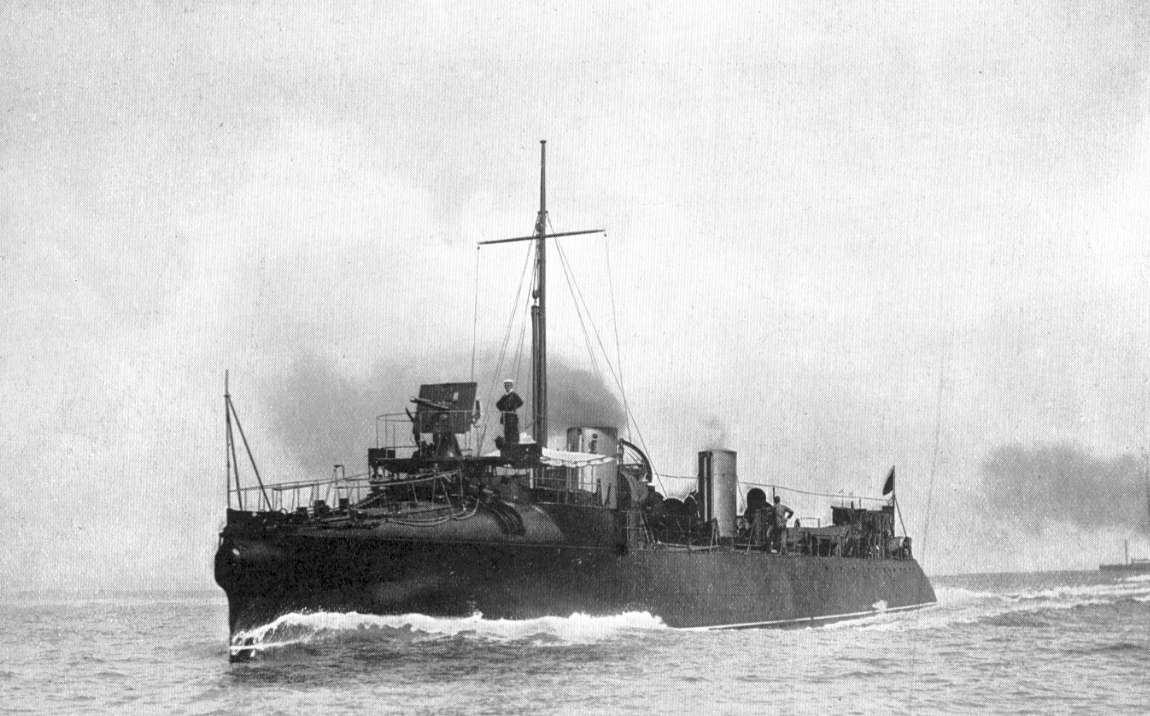
HMS Daring, 27-knotters in the late 1890s. At that time these ships had a black hull and sand colour superstructures.
Design of the 27-knotters
All differed according to their manufacturer and their displacement ranged from 295 to 365 tonnes fully loaded for 61-62 meters long. Their engine power also varied greatly, from 3600-4800 HP. Their shape also, according to their arrangements of machines and weapons. However, they all had triple-expansion machines, except the three ships built by Thornycroft, fitted with a four-cylinder Compound.
Hull and general design
A typical 27-knotter was a stretched 26-knotter generally with four funnels. The Ardent-class for example was a glorified 26-knot Daring class, larger with more output. The armament was specified early on to be single 12-pounder quick-firing (QF) forward, three 6-pounder guns broadside and aft, plus three single 18-inch torpedo tubes: One in the bow two on revolving mounts abaft the funnels. Often the froward fixed tube was removed for seaworthiness, leaving these with just two tubes. By October 1893 the bow tube was eliminatyed for good, not included on almost all ships completed to “clean sharp stem with no projections”. Two extra 6-pdr guns were installed en echelon amidships to compensate. These became the first British TBs without fixed bow tube. The crew varied over time, but generally comprised 2 officers and 48 ratings, 20 on the “deck department”, mostly manning guns, 28 in the engine room. The captain was generally a Lieutenant.
Powerplant

HMS Fervent as built in sea trials. Note her single large funnel for the two loco boilers with exhausts so close, they were not even truncated together. She was reboilered after completion and changed in appearance

HMS Fervent after reboilering.
Powerplants were very diverse, left to the discretion of various yards, although specifications were simple: Two propellers (thus two shafts, two steam engines) for 27 knots. All adopted vertical triple-expansion steam engines as standard, mostly from Thornycroft, but this could vary. The greates adjustmùent variable was in boilers. The first class for example had loco boilers and caracteristics funnels close together. But they were considered obsolete. Water Tubes boilers became the norm but they varied considerably between yard’s choices and arrangements. Typically two to eight boilers with truncated funnels sometimes into three funnels, although some had four, and some had two with further truncating, changing their appearance considerably.
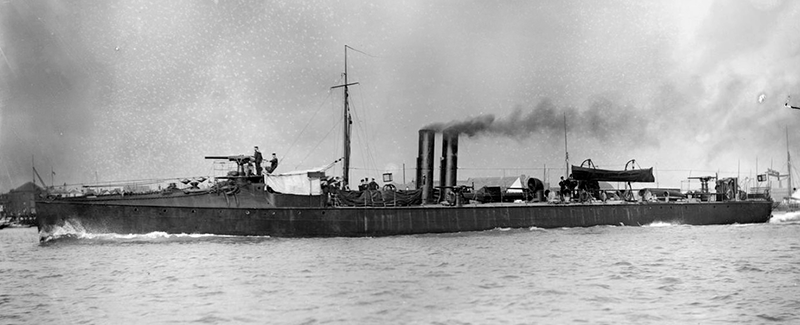
HMS Hasty in sea trials, showing her two narrow tall funnels, loco boilers.
-Ardent class (Thornycroft): 2x 3-cyl VTE, 3 Thornycroft boilers
-Janus class (Palmers): 2x 3-cyl VTE, 4 Reed boilers
-Banshee class (Laird): 2x 3-cyl VTE, 4 Normand boilers
-Handy class (Fairfield): 2x 4-cyl VTE, 3 Thornycroft boilers (2 funnels)
-Rocket class (J&G Thomson): 2x 4-cyl VTE, 4 Normand boilers (3 funnels, mid truncated)
-Charger class (Yarrow): 2x 3-cyl VTE, 2 locomotive fire-tube boilers (later 4 Yarrow water-tube boilers)
-Haughty class (Doxford): 2x 3-cyl VTE, 8 Yarrow boilers
-Salmon class (Earle): 2x 3-cyl VTE, 8 Yarrow boilers
-Sunfish class (Hawthorn Leslie): 2x 3-cyl VTE, 8 Yarrow boilers
-Sturgeon class (Naval Construction & Armament Co): 2x 4-cyl VTE, 4 Blechynden boilers
-Swordfish class (Arsmtrong): 2x 4-cyl VTE, 8 Yarrow or White boilers
-Conflict class (White): 2x 4-cyl VTE, 3 White boilers.
-Fervent class (Hanna, Donnald & Wilson): 2x 3-cyl VTE, 2 locomotive boilers (later changed to 4x Reed boilers)
-HMS Success (): 2x 4-cyl VTE, 4 Thornycroft boilers.
-HMS Zebra (Thames Iron works): 2x 4-cyl VTE, 4 Thornycroft boilers.
Not only that, but they all underwent boilers, or tubes changes sometimes thrice in their career, changing again in appearance. In addition, renaming and renumbering did not simplified recoignition to say the least. 27 knots was the specified speed, and was reached by most, but not all classes. Some barely managed to reach 26 knots on trials.
Coal-capacity wise, this all differed between ships, but the average was 50-80t, for circa 1,200 down to 1,100 nmi (1,175 nm for the Sunfish class or 2,176 km; 1,352 mi) at 11 kn (20 km/h; 13 mph). This was not that bad, at 2,200 km for destroyers of that era.

Reed Water tube boilers cross section. These were installed on the Janus class, considered as the best 27-knotters.
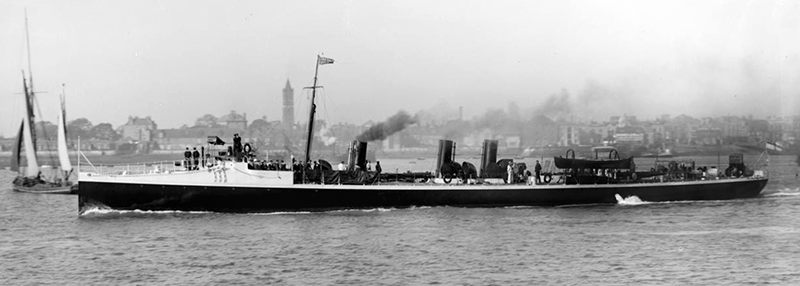
HMS Wizard as completed on sea trials, just reboilered
Armament
The Admiralty specifications were very clear about these new destoyer’s armament. Basically the same as for the 26-knotters: One 12 pdr (3-in gun), and three 6-pdr QF guns, two abaft the 12-pdr under bulwarks and two further aft on the sides. The bow tubes and two deck swivel mounted tubes saw most of the tube the bow tube removed from the early boats and not mounted on the remainder of the 27-knotters. Instead two extra 6-pdr were installed on the sides.
Q.F. 6-pdr on Mark IV H.A. mountings replaced their 12-pdr in 1920, just befored being sold for the ones that remained. The other change concerned the torpedo tubes. On many stability issues dictated the removal of one TT, the remaining one operated the short range Mark IV S.R.
Main: QF 12-pounder 12 cwt naval gun
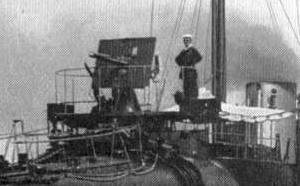 The QF 12-pounder 12 cwt naval gun was brand new when the 26-knotters were in construction, enterering service in 1894. placed on a raised platform overlooking the foredeck, and generally behind a platform protected by canvas. This 0.6 tons (510 kg) ordnance made a superb career going up to 1945, with more than 8,000 delivered. It was also used by Italy and Japan and became the staple of light artillery on most RN ships, especially those of WW1. In the case of these destroyers, the Mark I was shielded and placed on the conning tower platform, high enough to avoid water spray. But in heavy weather, as the ship were ploughing deep due to their turtleback, they were wet anyway.
The QF 12-pounder 12 cwt naval gun was brand new when the 26-knotters were in construction, enterering service in 1894. placed on a raised platform overlooking the foredeck, and generally behind a platform protected by canvas. This 0.6 tons (510 kg) ordnance made a superb career going up to 1945, with more than 8,000 delivered. It was also used by Italy and Japan and became the staple of light artillery on most RN ships, especially those of WW1. In the case of these destroyers, the Mark I was shielded and placed on the conning tower platform, high enough to avoid water spray. But in heavy weather, as the ship were ploughing deep due to their turtleback, they were wet anyway.
Specs:
It used a Separate-loading QF round, caliber 7.62 cm, with a single-motion screw breech.
Rate of fire was 15 rounds per minute, at 2,210 ft/s (670 m/s) for an effective range of 11,750 yd (10,740 m) at 40° for the latter version.
Secondary: 3-5 QF 6-pdr Hotchkiss
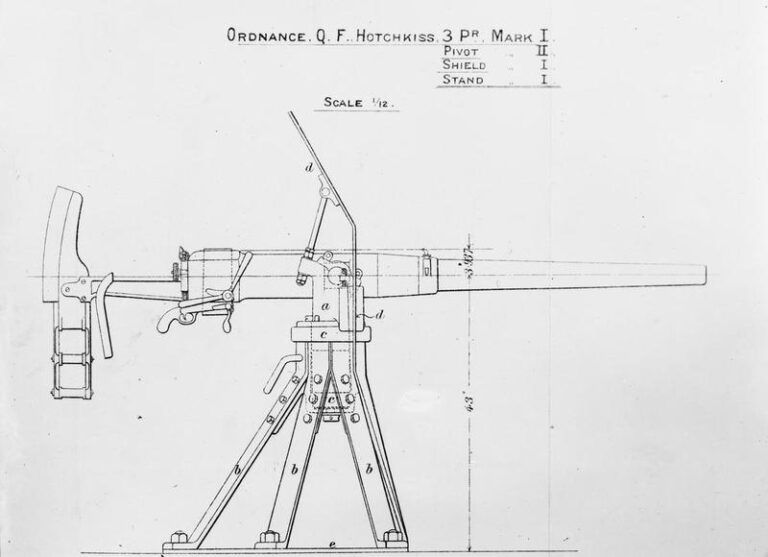
This “classic among classic” was developed in 1883 by Hotchkiss et Cie and a licenced was acquired by Elswick in Britain for mass manufacturing. It became the go-to light QF gun, still very much in favor by the 1890s. Weighting around 821–849 lb (372–385 kg) and shielded, the three guns were located forward for the first pair, abreast the main 12-pdr behind bulwark (but they were wet also) and the third was located on an axial platform aft, close to the stern.
Later in the early 1900s the side TTs were removed and replaced by two more, also shielded, placed on sponsoned platforms for a better arc of fire forward and aft.
Together with the 3-in gun (12 pdr) they could send 140 rounds every minute at the infortunate TB that could cross their path. They generally replaced the dismoured bow tube (not installed on the bulk of the 27 knotters).
Specs:
57x307R 57-millimetre (2.244 in), Vertical sliding-block breech, 4 inch hydro-spring recoil
Rate of fire 25/minute at 1,818 feet per second (554 m/s), range 4,000 yards (3,700 m)
Torpedo Tubes
The Type used was likely the 18-inches Whitehead (45 cm) type, developed in 1888, and introduced as the 26-27 knotters were completed in 1894:
They weighted 845 lbs. (383 kg) for 140 in (3.556 m) in lenght, with an explosive charge of 118 lbs. (53.5 kg) using wet gun-cotton, single setting, 800 yards (730 m) at 26.5 knots (which was actually slower than the destroyer’s top speed!). It was driven by a three cylinder radial Brotherhood pattern engine, fed by an Air-flask (cold running) of compressed air.
No upgrade as they were ultimately all retired. Outside the bow tube, the two other ones were axial, located aft, often before the aftermost funnel and close to the aft steering post and before the stern gun. Six torpedoes were carried, the three already in the tubes, and three spares.
specifications (Janus class) |
|
| Displacement | 275 long tons (279 t) |
| Dimensions | 204 ft oa x 19.5 ft x 8ft (62.26 x 5.94 x 2.44m) |
| Propulsion | 2 shafts VTE, 4x Reed boilers 3,900 hp (2,908 kW) |
| Speed | 27 knots (50 km/h; 31 mph) |
| Range | 1,175 nmi (2,176 km; 1,352 mi) at 11 knots* |
| Armament | Standard 1×12-pdr, 5x 6-pdr, 2x 18-in TTs |
| Crew | 53 |
*Sunfish class
Appearance
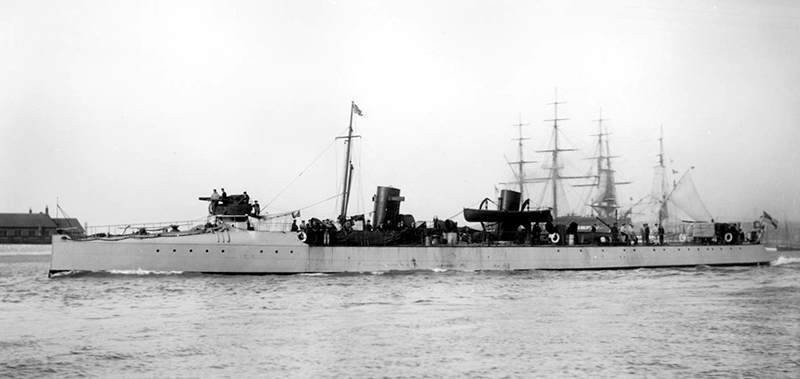
HMS Boxer, showing all all-white hull, black waterline and superstructures, red or most often all black underbelly (less visible), sand canvas barriers, no wooden decks after the forecastle but all reddish dark or dark grey metal.
This is a quite interesting topic. There were researches made on the first 27-knotter to determine the best appearance for these ships, but not only this evolved over time, but also between ships of a single class. Not that i don’t even speak of their silhouette, which varied considerably between classes, single ships, and over time as well. The pennants numbers alone changed three times, and their classifications also thrice.
Color-wise, most had black hull, which was seemingly the best disguise under covered weather. Also superstructures were black-painted, but the forecastle and part of the superstructures were also often white. Some had also canvas sand color superstructures, including the turtleback forward, white hull, and medium grey canvas. See HMS Banshee model kit.

HMS Janus, all black livery.
Construction
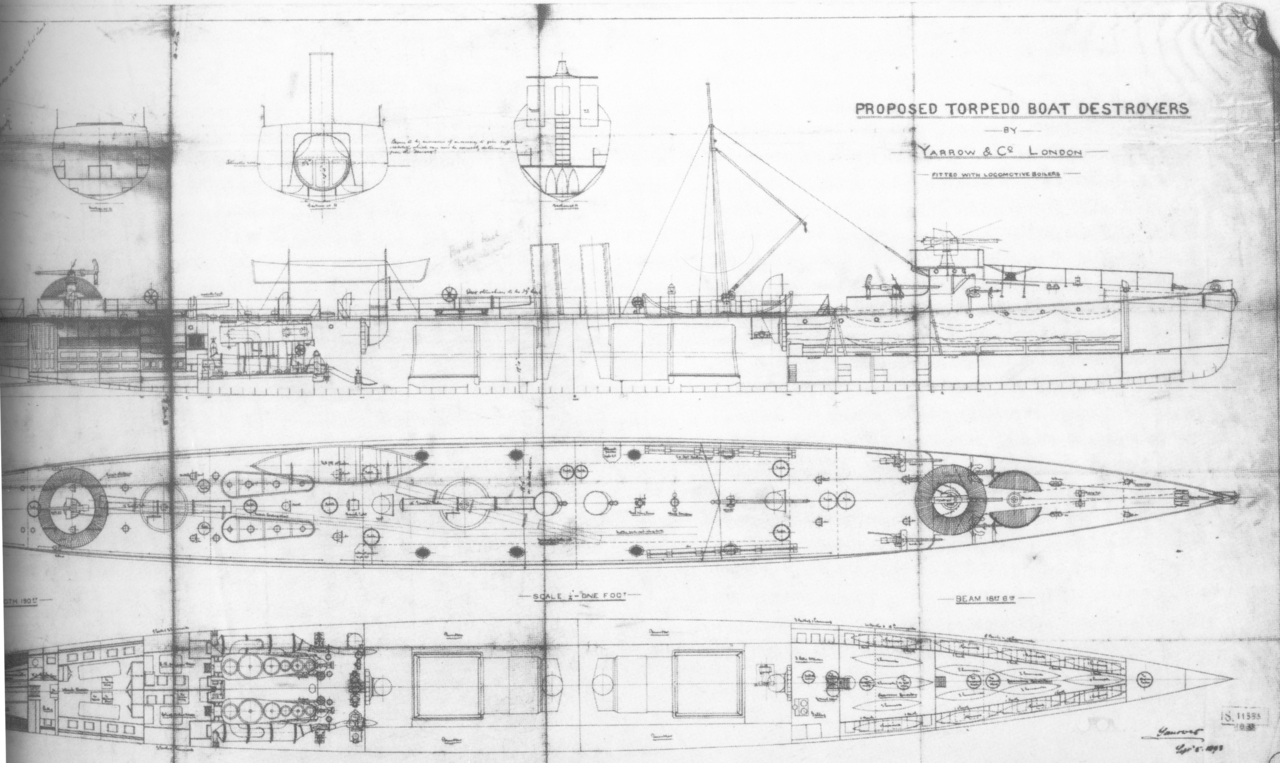
Plans of Thonycroft’s Charger class with the original loco boilers. This was an obolete tech when completed, tnad they were rebuilt to small tubes boilers, changing their narrow funnels apperance to three far apart.
Initially six torpedo boat destroyers, Thornycroft and Yarrow vessels only for comparative tests ordered under the 1893-94 Programme. However the “russian scare” of the time pushed the admiralty to ordered a series of follow-up orders so the 27 knotters jumped to 36 vessels total, the bulk of the “A” class as none of the 26-knotters were still active in 1914. In addition, only about 1/3 of the 27 knotters (records for those only). Initial Estimates for £651,000 were destined to 14 destroyers only, with a last-minute postponement of the 1st Class cruiser programme enabling fundng for 25 destroyers on order that year, the balance of 11 funded under the 1894-95 Estimates, and yet still part of the 1893-94 Programme.

Plans of HMS Spitfire, Sturgeon class.
Active service
Only a fraction of the 27-knotters saw action in WW2. Generally instead of being scrapped and stricken in 1912 or later, inspection showed their general excellent maintenance records and little speed loss if any. They had the best and most durable powerplants. This was generally the winning criteria here. But the situation still can change from a builder to another. Some in the same class were either stricken or maintained until 1914. One that narrowly missed the war was HMS Zebra, sold for breaking up on 30 July 1914, a few days before.
The ships that actually took part in the great war were the following:
-HMS Boxer (lost in collision with SS St Patrick in the Channel 8 February 1918).
-HMS Conflict
-HMS Wizard
-HMS Fervent
-HMS Zephyr
-HMS Lightning (sunk, probably by mine, 30 June 1915).
-HMS Porcupine
-HMS Sunfish
-HMS Opposum
-HMS Ranger
-HMS Surly
The only lost in action as saw here was HMS Lightning, sunk probably by a mine in 1915. These three ships, with HMS Porcupine and Janus (built by Palmer) were considered the best in the series, the most seaworthy.
They narrowly escaped the scrapyard: In 1905 already, Rear Admiral (Destroyers) condemned al the 27-knotters as being “..all worn out”, with “every shilling spent on these old 27-knotters is a waste of money”. They were often semi-mothballed and their boilers proved troublesome, they spent many years combined on refits, re-tubing most of the time. He recommended that they be withdrawn from flotilla use and used either as tenders to training schools, or as local defence torpedo boats, or disposed of altogether.
They were rapidly sidelined. Many of the 27 knot destroyers took part in the 1896 and 1899 naval exercises were not present in the 1900 Manoeuvers, completely superseded by the 30 knotters. From there, and in between collisions (at least each one had one of several of these) and frequent retubing, they were mostly attached as tenders of other ships and establishments, still taking part in the naval reviews for Queen Victoria Golden Jubilee and King Georges VII Coronation.
Critics were many. Like the 30-knotters they were criticized for the emphasis on maximum trial speed, carried on light fuel load without armament, and thus, the top speeds achieved were never realized in service. In practice they were down to 18 knots at best and this started to cause issues in fleet manoeuvers as they could not keep up with cruisers. And this was their best speed when the sea was a lake. In heavy weather their turtleback foredecks threw blinding level of water spray, bridges and deck being very wet at high speed. The position of the 12-pounder gun was also criticized as it interfered with command of the ship. Some still active in WW1 received a modified bridge structure wih an enclosed platform and the bridge moved on top but it mostly concerned the 30 and 33 knotters.
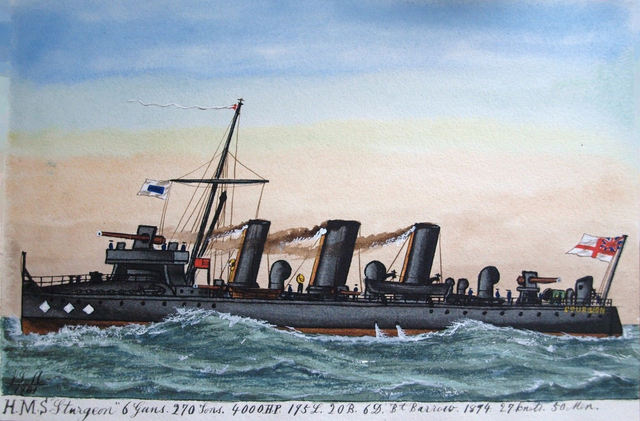
HMS Sturgeon by James Scott Maxwell.
On 30 August 1912 they were all grouped into classes designated by letters, based on contract speed and appearance. After 30 September 1913 this was the A class for all 26 and 27 knotters.
By February 1913 most of thse destroyers were no longer part of an active flotilla, and rather attached as tenders to a various shore establishments and nucleus crew, only charged of basic maintained. Thanks to this, a dozen were still active when WWI broke out. If the First World War saw them in rather “static” assignments in various ports; as the war progressed the the U-Boat campaign intensified, their patrols did so too, including sometimes hunting sorties, for which they had received all depht charges (details not known with precision), likely stern racks.
They also occasionally rescued crews of sunken trade ships close to the shore.
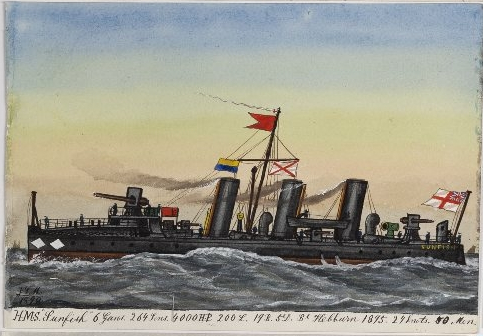
Painting of HMS Sunfish by James Scott Maxwell
Kills were rare, as well as encounters with enemy torpedo boats. The A class was spared as much as possible given their fragile machineries and indeptitude of service in heavy weather. By January 1915, for example, HMS Opossum was part of the Devonport Local Defence Flotilla but took a more active role by the the evening of 20 December 1917. Together with the destroyers HMS Spitfire and Roebuck of her own A-class, plus five Motor Launches to screen them, and four drifters, two fishing trawlers covering all angles, she was ordered to patrol Lyme Bay, looking, searching for a German submarine which recently has been signalled sinking three merchant ships the previous night, but the U-Boat already left the area and they found nothing but a few survivors.
However on 8 August 1918, she ahd more luck: The minelayer sub (they were feared, sinking more than 1,800 vessels for the UC-II class alone) UC-49 layed a minefield off Start Point (Devon) when fouled one of her own mines. The explosion was spotted by the patrolling nearby HMS Opossum on a routine ASW patrol and so, with several Motor Launches which accompanied her (as a mini-flotilla) she started a search towards the site, using recently installed Hydrophones, sweeping the whole area. UC-49 was believed to sit on the sea bed. So the Oppossum’s captain decided to stop as well and just wait. So when the submarine restarted motors at 15:20 pm, this was immediately picked up by the destroyer, which also dropped depth charges, and went on until her racks were near-depleted at 17:57 pm.
She then noisily withdrew at 2.5 nautical miles (4.6 km; 2.9 mi) as a ruse, then slowed down and then shut down its engines to convince the U-Boat commander she was away. After 17 minutes, sure enough, the already badly shaken UC-49 surfaced just 200 yards (180 m) from one of the Motor Launches, 800 yards (730 m) from Opossum. Now just put yourself in the shoes of the U-Boat captain when he realized and probably exclaimed the meme-like “it’s a trap!” and was immediately found under heavy fire, including machine guns and rifles for the launches. After 20 seconds, she resubmerged, but very fast and in an unbalanced way, at an angle of 50 degrees. Oppossum then came for the coup de grace, as she was probably stuck at the bottom. She dropped the remainder of her depth charges eventually bringing up oil and bubbles. She marked the site and went back to port to resupply. The next day, the wreck was located again, and litteraly plastered with depth charges to confirm the kill. Debris, including a light bulb manufactured in Vienna were picked up at the surface, confirming the kill for good. This was the only one confirmed for any 27-knotter.
Others would have many “probable kills”. So ultimately these old vessels still proved their worth. The following career section will go into lenght on their wartime career.
Sources
Books
Chesneau, Roger & Kolesnik, Eugene M., eds. (1979). Conway’s All The World’s Fighting Ships 1860–1905. London: Conway Maritime Press.
Colledge, J. J.; Warlow, Ben (2006). Ships of the Royal Navy: Complete Record of all Fighting Ships of the Royal Navy. Chatham Publishing.
Dittmar, F.J.; Colledge, J.J. (1972). British Warships 1914–1919. Shepperton, UK: Ian Allan.
Friedman, Norman (2009). British Destroyers: From Earliest Days to the Second World War. Barnsley, UK: Seaforth Publishing.
Gardiner, Robert & Gray, Randal, eds. (1985). Conway’s All The World’s Fighting Ships 1906–1921. London: Conway Maritime Press
Lyon, David (2001) [1996]. The First Destroyers. London: Caxton Editions.
Manning, T. D. (1961). The British Destroyer. London: Putnam & Co.
March, Edgar J. (1966). British Destroyers: A History of Development, 1892–1953. London: Seeley Service.
Links
dreadnoughtproject.org/
on historyofwar.org/
The 27-knotters on wikipedia
White 27-knotters on navypedia
Model Kits
Combrig 1:700 HMS Spitfire 1895 review
Gallery

1/750 Profile of a 27 Knotter torpedo-boat destroyer, HMS Lighting (Laird) in 1915.
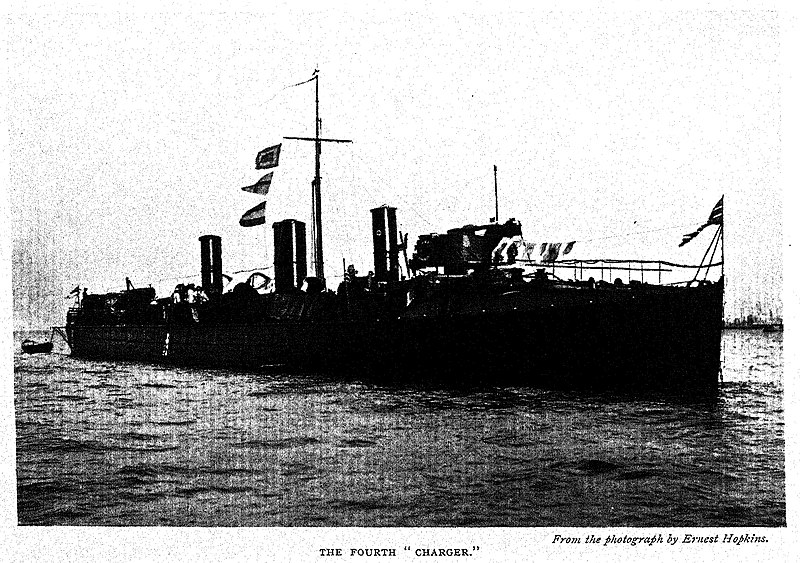
HMS Charger by Ernest Hopkins, after reconstruction.
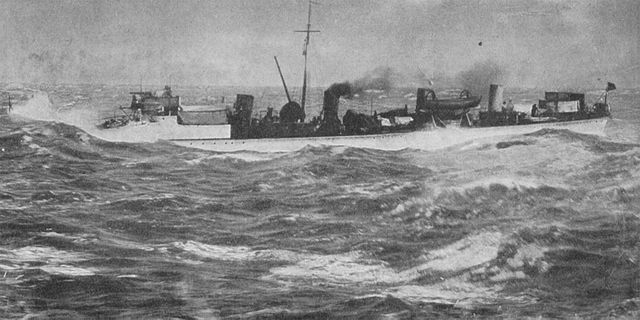
HMS Banshee in rough weather, 1899. Note her white livery and turtleback foredeck proper to her class
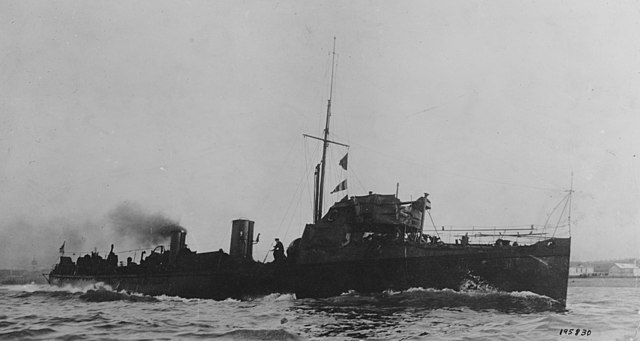
HMS Wizard, Conflict class, after refit, with two funnels truncated into one. Still active like the latter in WWI.
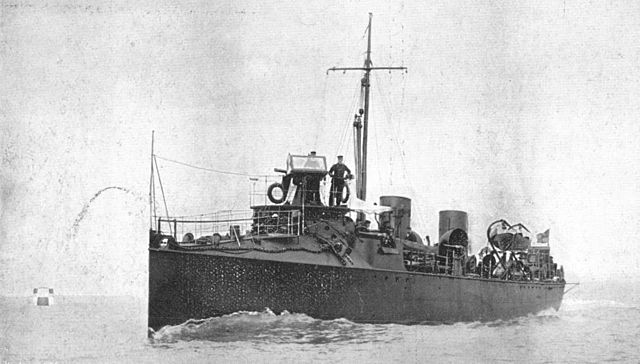
HMS Hunter (1895) of the Handy class, Scanned by Steven Johnson from “The Navy and Army Illustrated’, circa 25 June 1897.
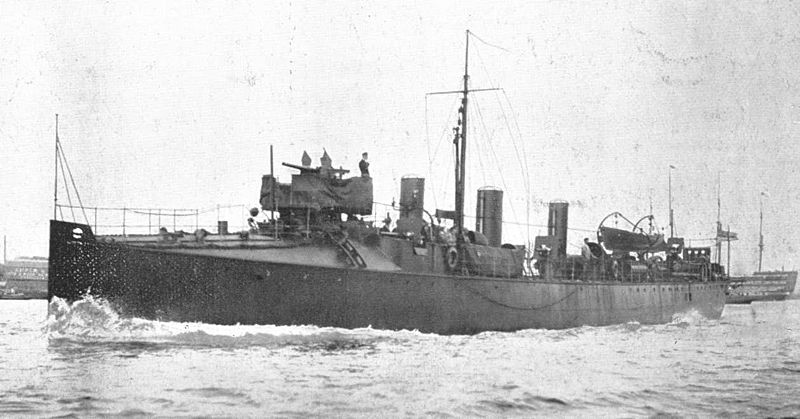
HMS Ranger, Sunfish class (Hawthorn Leslie)
All sub-classes by builder
 Ardent-class
Ardent-class

All built by John I. Thornycroft & Company, Chiswick. Quickspecs: 245 lts/301 ltfl, 201 ft 8 in x 19 ft x 7 ft 3.25 in (61.47 x 5.8 x 2.2162 m), 2 shafts TE, 2 Coal-fired WTB boilers 4353-4680 ihp for 27-29 kts, crew 50, one 12-pounder gun, 5 × 6-pounder guns, 2 × 18 inch (450 mm) torpedo tubes (same for all following for the powerplant and armament, not mentioned anymore but the output).
HMS Ardent: Launched 16 October 1894, sold for breaking up 10 October 1911.
HMS Boxer: Launched 28 November 1894. In May 1896, Mediterranean Squadron, helped to determine the optimum colour scheme for torpedo boats, to avoid being spotted in night attacks. From 1 January 1902 commanded by Lt. Bertram Owen Frederick Phibbs, repairs, re-tubed boilers same year. Visited Lemnos in August. Home waters 1911, 6th Destroyer Flotilla. 30 August 1912 redesignated by letters based on contract speed and appearance. 30 September 1913, part of the A class. March 1913 tender to the training establishment Excellent with a nucleus crew.
June 1915, Portsmouth Local Defence Flotilla. Lost in collision with SS St Patrick in the Channel 8 February 1918, all but one survived.
HMS Bruizer: Launched 27 February 1895, sold for breaking up 26 May 1914.
 Charger-class
Charger-class
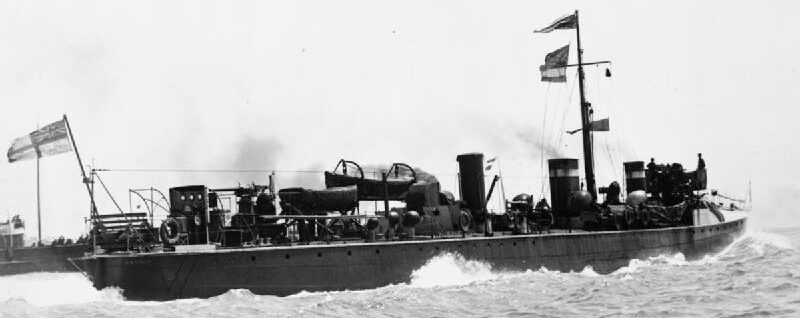
HMS Dasher in 1895, IWM
They were built by Yarrow Shipbuilders Ltd, Poplar. 255 lts/295 ltfl, 195 x 18.5 x 7.25 ft, 2 shaft VTE, Normand loco boilers (1899-1900: 4 Thornycroft WT boilers), 3,800 hp 27 knots, crew 50. Not the fastest of the bunch, they topped 25-26 knots on trials. Their Locomotive boilers being made obsolete by water-tube boilers when completed they were refitted at Earle’s Shipbuilding in 1899–1890 with water-tube boilers, and from two narrow funnels, their appareance changed to three-funnels further apart.
HMS Charger, launched 15 September 1894, sold for breaking up 14 May 1912.
HMS Dasher, launched 28 November 1894, sold for breaking up 14 May 1912.
HMS Hasty, launched 16 June 1894, sold for breaking up 9 July 1912.
 Banshee-class
Banshee-class

Built by Laird Brothers, Birkenhead. 290 lt standard, 210 x 19 x 7 ft (64 x 5.8 x 2.1 m), 2 shafts VTE, 4 Normand boilers, 4,400 horsepower (3,300 kW) top speed 27 knots, crew 53.
HMS Banshee: launched 17 November 1894, sold for breaking up 10 April 1912.
HMS Contest: launched 1 December 1894, sold for breaking up 11 July 1911.
HMS Dragon: launched 15 December 1894, sold for breaking up 9 July 1912.
 Conflict-class
Conflict-class

Built by J. Samuel White, Cowes. 320 long tons Length 200 ft (61 m). 2 shafts VTE, 4x White-Forster boilers 4,500 hp (3,356 kW), crew 53.
HMS Conflict: Launched 13 December 1894. After commission by July 1899, served at the Mediterranean station, tender to Victorious. Gunnery/tactical exercises Arucas, Las Palmas. Plymouth 5 July 1902, PO 24 July. 1910 6th Destroyer Flotilla, at the Nore, refit Chatham Dockyard. March 1913 Portsmouth, tender to the torpedo school HMS Vernon with nucleus crew. 1 November 1914 Portsmouth Local Defence Flotilla. 24 November escorted transports from Southampton to Le Havre. 4 June 1917, close behind TB 98 which attacked and missed an U-Boat, dropped two depth charges. Later judged “improbable” kill. Portsmouth Local Defence Flotilla still by August-Dec. 1918, paid off. Sold for breaking up 20 May 1920.
HMS Teazer: launched 9 February 1895, sold for breaking up 9 July 1912.
HMS Wizard: launched 27 February 1895. Com. July 1899, tender to Excellent, Portsmouth. December 1901 (LtCdr Frederick Hare Hallowes) damaged in a collision with tug, Portsmouth. PO Portsmouth 13 May 1902 to be strengthened. Fleet review Spithead 16 August 1902 coronation King Edward VII.. Oct. 1902 collision with German liner Kronprinz Wilhelm in Southampton. 8 November Portsmouth instructional flotilla. Refit White 1904–1904. 1908 docked Sheerness Dockyard examined for other refit, completed April 1909. Nore flotilla. 1910 two funnels trunked together. November 1909: Escorted scout cruiser HMS Forward, depot ship Vulcan, ten C-class submarines to Dundee, Scotland. 3 September 1910 rammed by other DD in Thames Estuary. Repaired Sheerness. February 1913 tender to HMS Excellent gunnery school, Portsmouth, nucleus crew. Fully recom. Portsmouth Local Defence Flotilla June 1915 until March 1917. Sold for breaking up 20 May 1920.
 Fervent-class
Fervent-class
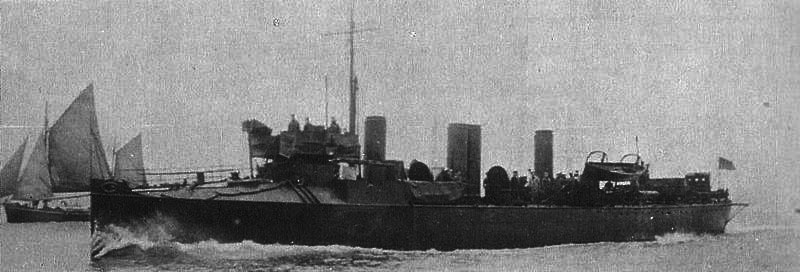
Built by Hanna, Donald & Wilson, Paisley. 275 long tons, Length 200 ft (61 m), 2 shafts VTE, 4 boilers, 3,850 shp (2,871 kW), crew 53.
HMS Fervent: launched 20 March 1895, comp. June 1901. 1901 Naval Manoeuvres. Strenghtened Portsmouth after hull damage heavy weather. Portsmouth instructional flotilla. 1910-1912, 6th Destroyer Flotilla, The Nore. Ran aground Maplin Sands 26 November 1910, Court Martial. February 1913 attached as tender to torpedo school Chatham, nucleus crew. February 1915, Local Defence Flotilla, The Nore until November 1918. Paid off Chatham 26 April 1919. Sold for breaking up 20 May 1920.
HMS Zephyr: launched 10 May 1895, completing July 1901, last of the “twenty-seven knotters”. Naval Manoeuvres of July 1901. Instructional tender to Cambridge gunnery schoolship, Portsmouth instructional flotilla until April 1902. Refit, strengthened after hull damage in heavy weather, Channel. Fleet review Spithead 16 August 1902. 18 August 1904 rammed by Torpedo Boat No. 68 in Portsmouth and 4 February 1908 when ramming Cricket-class TB 2 in Portsmouth. 1910-1912 6th Destroyer Flotilla, The Nore. 14 June 1911 collided with Zebra during night exercises in River Thames. Harwich submarine flotilla. February 1913 tender to torpedo school Chatham, nucleus crew. Summer 1914 Nore Local Defence Flotilla until August 1916. Refit summer 1917 until February 1918, Irish Sea Flotilla until November. Sold for breaking up 20 May 1920.
 Handy-class
Handy-class
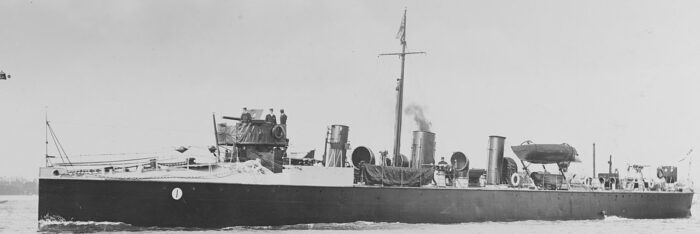
Built by Fairfields, Govan. 275 long tons (279 t)n Length 194 ft (59 m), 2 shafts VTE, 4x Thornycroft boilers 4,000 hp (2,983 kW), crew 53. All three served in the China Flotilla but were stricken or BU before WWI.
HMS Handy: Launched 9 March 1895, commissioned in October 1895. Portsmouth destroyer flotilla. Tested, good seaboat, deployed to overseas station Hong Kong 1897–1898, China Station. Bow structure strengthened April 1901. January 1901 salvaging dredger Canton River after Typhoon November 1900. November 1911 Xinhai Revolution, ferried Chang Ming-Ch’i (Governor-General of Kwangtung province) to safety in Hong Kong. Paid off 1912. March 1913 sale list, sold Hong Kong 1916.
HMS Hart: Launched 27 March 1895, sold for breaking up 1912 at Hong Kong.
HMS Hunter: Launched 28 December 1895, sold for breaking up 10 April 1912.
 Hardy-class
Hardy-class
built by William Doxford & Sons, Sunderland. 260 long tons (264 t) standard (lts) 325 long tons (330 t) full load (ltfl) 200 ft 3 in x 19 ft x 7 ft 9 in (61.04 x 5.8 x 2.36 m), 2 shafts VTE, 8 Yarrow boilers. Same speed, armament and crew as the others. No cc photo.
HMS Hardy: launched 16 December 1895, served in the Med Squadron. Sold for breaking up 11 July 1911.
HMS Haughty: launched 18 September 1895, Medway and 6th flotilla. Sold for breaking up 10 April 1912.
 Janus-class
Janus-class
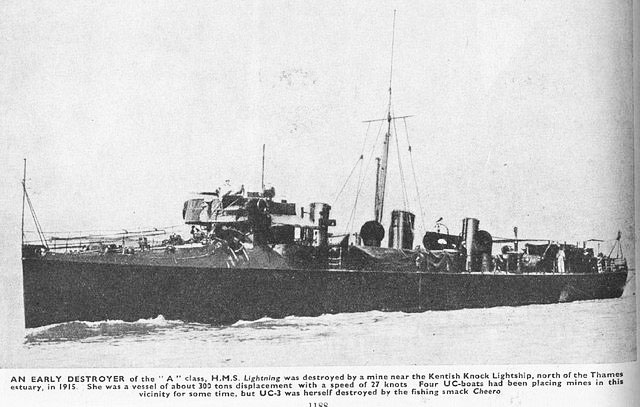
Built by Palmers, Jarrow. 275 long tons (279 t), 204 ft 6 in x 19 feet 9 inches x 8 feet (62.33 x 6.02 x 2.4 m). 2 shafts VTE, 4x Reed boilers 3,900 hp (2,908 kW). Good sea boats, one was sent to China Station. The Palmer-built ships were considered the best of the 27-knotters.
HMS Janus: Launched 12 March 1895. Tender to HMS Goliath, China Station, served on that station for most of her career. Re-tube her Reed boilers in 1902. Sold for breaking up 1912 at Hong Kong (other sources tells BU 1914).
HMS Lightning: Launched 10 April 1895, completed January 1896. Comm. home waters, 1896 British Naval Manoeuvres, Channel Fleet (trained from southern Ireland), based at HMNB Portsmouth, tender to Excellent in 1900. Re-tube boilers 1902 and again at Sheerness 1907. HP Portsmouth. 17 February 1908 rammed a mooring buoy, Portsmouth harbour. 1910 6th Destroyer Flotilla, The Nore until 1912. 25 April 1912 collided with TB 17 in Stangate Creek. As N.23, Nore Local Defence Flotilla January 1915. 30 June sent out to deal with mines, destroyed three before struck another (laid by UC-1). She broke in half, sank, lost 15 out of 53. Stern stayed afloat, towed back to Sheerness, later scrapped.
HMS Porcupine: Launched 19 September 1895, completed March 1896. Chatham, 1896 British Naval Manoeuvres, Channel Fleet operation from Milford Haven. Refit Chatham late 1899, Fleet Reserve 15 January 1900. Medway Instructional Flotilla. PO Chatham 31 July 1902, boilers retubed. Fleet review Spithead 16 August 1902. 1910, 6th Destroyer Flotilla, The Nore until 1912. Ran aground off Clacton 18 October 1910, Court Martial. February 1913 tender torpedo school Chatham, nucleus crew. The Nore until November 1917. Sold for breaking up 29 April 1920.
 Sunfish-class
Sunfish-class

HMS Ranger, Sunfish class (Hawthorn Leslie)
built by Hawthorn, Newcastle upon Tyne. As completed they had eight Yarrow or White boilers for 4,000 hp (2,983 kW) and were armed by one single forward 12 pounder gun and two swivel-mount torpedo tubes. Later five 6-pdr were installed. Rather successful, they all saw service in WW2.
HMS Sunfish: Launched 9 August 1895, comm. Chatham on 18 February 1896, replaced Havock as tender to HMS Royal Sovereign, Channel Fleet. 1896 British Naval Manoeuvres. Mediterranean Fleet, boiler problems, repairs Malta 1900-1902 (boilers re-tubed, bottom reservoirs repaired). June 1902 Gibraltar, then Plymouth, Chatham PO. Medway instructional flotilla. Damaged at Dundee in a gale. 1905, condemned as being “..all worn out”, with “every shilling spent on these old 27-knotters is a waste of money” but retained after examination.
6th Destroyer Flotilla Devonport 1910-1912. 5 June 1911 collided with Havock at Waterford Harbour, and then TB 045. February 1913 tender to Vivid at Devonport, nucleus crew and still from July 1914 to the end of WWI, but January 1915, Devonport Local Defence Flotilla. 23 July 1917 hunted down U-Boat spotted in Lyme Bay. Sold for breaking up 7 June 1920.
HMS Opposum: Launched 4 October 1895, comp. February 1896. 26 June 1897 naval review, Spithead (Golden Jubilee Queen Victoria). Based at Devonport, summer 1901 Royal Navy Naval Manoeuvres. November 1907 refit Chatham, boilers retubed, until June 1908. February 1913 tender to SE Vivid at Devonport, nucleus crew. January 1915 Devonport Local Defence Flotilla. 1 April 1917 salvage of merchant ship SS Valacia. 20 December 1917 patrolled Lyme Bay to search for U-Boat. 8 August 1918 looked for UC-49 off Start Point, Devon, found and sunk. March 1919 laid up reserve Devonport, sold for breaking up 29 July 1920.

HMS Oppossum at sea.
HMS Ranger: Launched 28 May 1895, comp. June 1896. Reserve Chatham, naval review Spithead (Queen Victoria Jubilee), then from 1901, based at Portsmouth. On 2 July 1908 (annual Naval Manoeuvres) she collided with the destroyer Haughty. Her hull hole was patched with canvas until she was back to Chatham. August 1910, Nore Destroyer Flotilla. Another collision (pier) and repaired at Sheerness.n 5 November, 6th Destroyer Flotilla, ran aground off Selsey Bill. Repaired Portsmouth. In June 1911 collided with pleasure steamer King Edward in Torquay harbour, repaired in Devonport. March 1913, tender to SE Vivid Devonport, listed for sale but recom. on March 1915, 7th Destroyer Flotilla, East coast. Local Defence Flotilla Portsmouth until January 1917, unlisted, reserved, sold for breaking up 20 July 1920.

HMS Ranger underway
 Rocket-class
Rocket-class
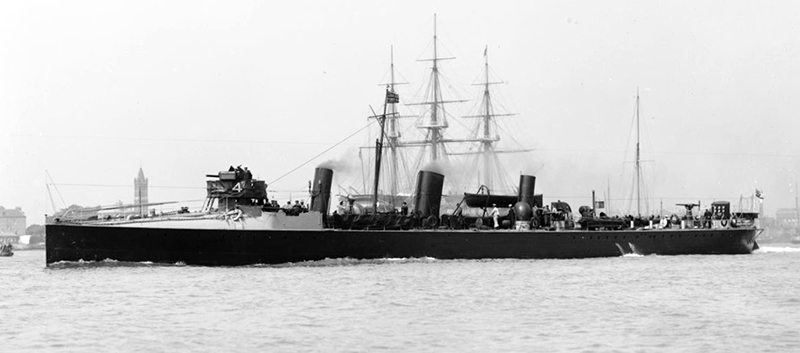
HMS Shark underway
Built by J & G Thomson (later to become John Brown and Company), Clydebank. They displaced 280 long tons (284 t) for a hull 200 ft (61 m) long, powered by two VTE, fed by four Normand boilers for an output of 4,100 hp (3,057 kW).
HMS Rocket, launched 14 August 1894, was sold for breaking up 10 April 1912.
HMS Shark, launched 22 September 1894, was sold for breaking up 11 July 1911.
HMS Surly, launched 10 November 1894, commissioned in July 1895, was based at Portsmouth. 1901 British Naval Manoeuvres. 1898 was used in sea trials using oil fuel instead of coal, until 1906. March 1913 nucleus crew, Portsmouth, tender HMS Fisgard until July 1914. Became a member of the Portsmouth Local Defence Flotilla. She was sold for breaking up 23 March 1920.
 Salmon-class
Salmon-class

HMS Snapper underway.
Built by Earle’s, Kingston upon Hull. They were among the largest, displacing 305 long tons (310 t) for 200 ft (61 m) in lenght and powered bt two VTE engines and 4 Yarrow boilers for 3,600 hp (2,685 kW).
HMS Salmon: launched 15 January 1895. In late 1901 she was damaged in a storm, temporarily repaired at Harwich by December, PO at Sheerness, drydocked, refitted with her decks strengthened until December 1902. Fleet Reserve Chatham. Sold for breaking up 14 May 1912.
HMS Snapper: launched 30 January 1895, served as part of the Medway Instructional Flotilla 1901. Stem repaired in late May 1902. Fleet review held at Spithead 16 August 1902 (coronation King Edward VII). Sold for BU the same day as her sister.
 Sturgeon-class
Sturgeon-class

HMS Sturgeon in 1896, note the interesting hull livery, with the forward section in black, after section in grey.
Built by Naval Construction and Armament Company (later to become Vickers and eventually Vickers-Armstrongs), Barrow in Furness. Dimensions 194 feet 6 inches (59.28 m) oa, beam 19 feet (5.79 m)a draught of 7 feet 7 inches (2.31 m). Displacement 300 long tons (300 t) light, 340 long tons (350 t) deep load. Three funnels. 2 shafts 3-cyl. VTE, 4 Blechyndnen water-tube boilers (200 pounds sq-in or 1,400 kPa), 4,000 ihp (3,000 kW). 60 tons of coal, range 1,370 nautical miles at 11 knots.
HMS Sturgeon: launched 21 July 1894, home waters, fleet review Spithead 26 June 1897. From 1899 Medway Instructional Flotilla until March 1900. Back Medway instructional flotilla. Refit early 1902. May recommissioned at Chatham Flotilla. Spithead fleet review 16 August 1902. Refit Sheerness, little service afterwards, sold for breaking up 14 May 1912.
HMS Starfish: launched 26 January 1895, home waters. Had failures of her propeller brackets (forged scrap iron). January 1900 tender for gunnery school HMS Excellent. Tested a modified spar torpedo as ASW weapon (42 feet 13 m long spar with explosive charge swung out and immersed in action, detonated as the submarine passed). Torpedo school HMS Vernon, Portsmouth 1901, Naval Manoeuvres. Fleet review Spithead 16 August 1902. April 1903 trials with kites designed by Samuel Cody (for lifting radio antennae). 26 October 1907 minor collision with Daring at Devonport. Sold for breaking up 15 May 1912.
HMS Skate: launched 13 March 1895, 1900, Mediterranean station, but back home early 1902. Gibraltar 9 May, convoyed cruiser HMS Astraea to Plymouth. PO Devonport 20 May, A Division Fleet Reserve. Fleet review Spithead 16 August 1902. Devonport instructional flotilla. Damaged by heavy sea (upper deck destroyed, fore-bridge too, fitting twisted). Drydock repairs. 1906 used as a target, firing trials. Conformed the validity of the 12-pdr gun. Sold for breaking up 9 April 1907.
 Swordfish-class
Swordfish-class
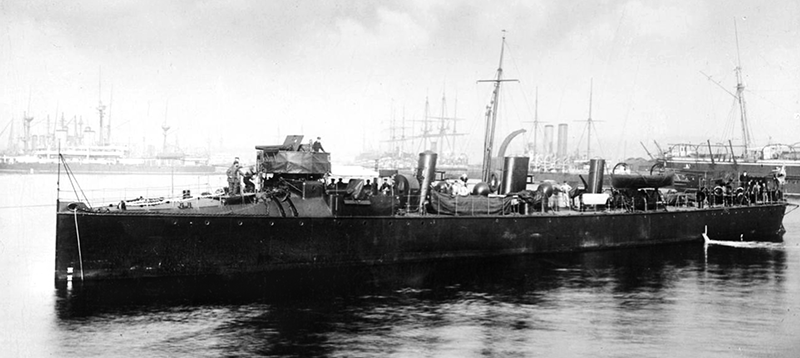
HMS Spitfire, official yard photo.
Built by Armstrong Mitchell and Company (later part of Vickers-Armstrongs), Elswick, Newcastle upon Tyne. The machinery was supplied by Belliss & Co of Birmingham: Two 4-cyl. VTE steam engines fed by eight Yarrow-type water-tube boilers (working pressure 200 psi (1,400 kPa)). Three funnels, admiship one truncated. Home waters, none was active in WWI.
HMS Swordfish: Launched 7 June 1895, commissioned on 7 March 1900, tender to HMS Wildfire, Sheerness. Chatham 1901, rotating with Sheerness and Portsmouth. April 1902 refit at Sheerness. Medway Instructional Flotilla. Fleet review Spithead 16 August 1902. Full armament mounted (1× 12 pounder, 5× 6-pounder, 2x 18-in TTs) stability concerned led to retire on torpedo tube. 1909 top speed fell to 18+1⁄2 knots (21.3 mph; 34.3 km/h), worn out. Placed in reserve. Sold for breaking up 11 October 1910.
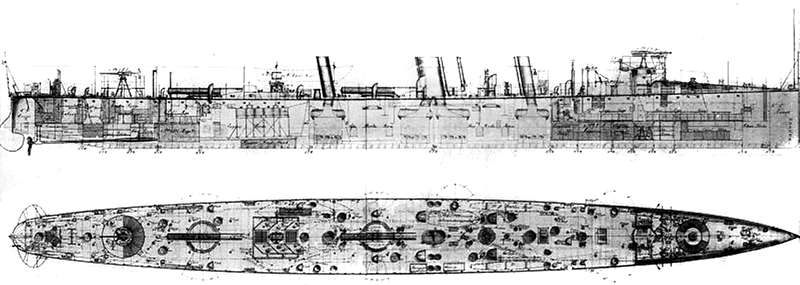
Plan HMS Swordfish
HMS Spitfire: Launched 27 February 1895, home waters. February 1900 repairs at Chatham, Medway instructional flotilla. Tender to SE Wildfire, Sheerness. Boilers re-tubed 1902. 7 May 1902 tender to cruiser HMS Immortalité at Sheerness. Sold for breaking up 10 April 1912.
 Zebra class
Zebra class

HMS Zbra was built by Thames Iron Works, Bow Creek, launched 13 December 1895. Thames Iron Works was relatively inexperienced. Took a long completion time and to complete trials, by January 1900. Not particularly successful in service. Home waters, tender to Wildfire SSV, training duties, Sheerness Naval School of Gunnery. 1901 British Naval Manoeuvres. Portsmouth Instructional flotilla May 1902. Spithead review 16 August 1902. 6th Destroyer Flotilla 1910-1912. 14 June 1911 collided with Zephyr in night exercises in the Thames. Submarine flotilla, Dundee. From 1912 class letters painted on the hull below the bridge area and funnel. March 1913 laid up Sheerness, sold 30 July 1914.

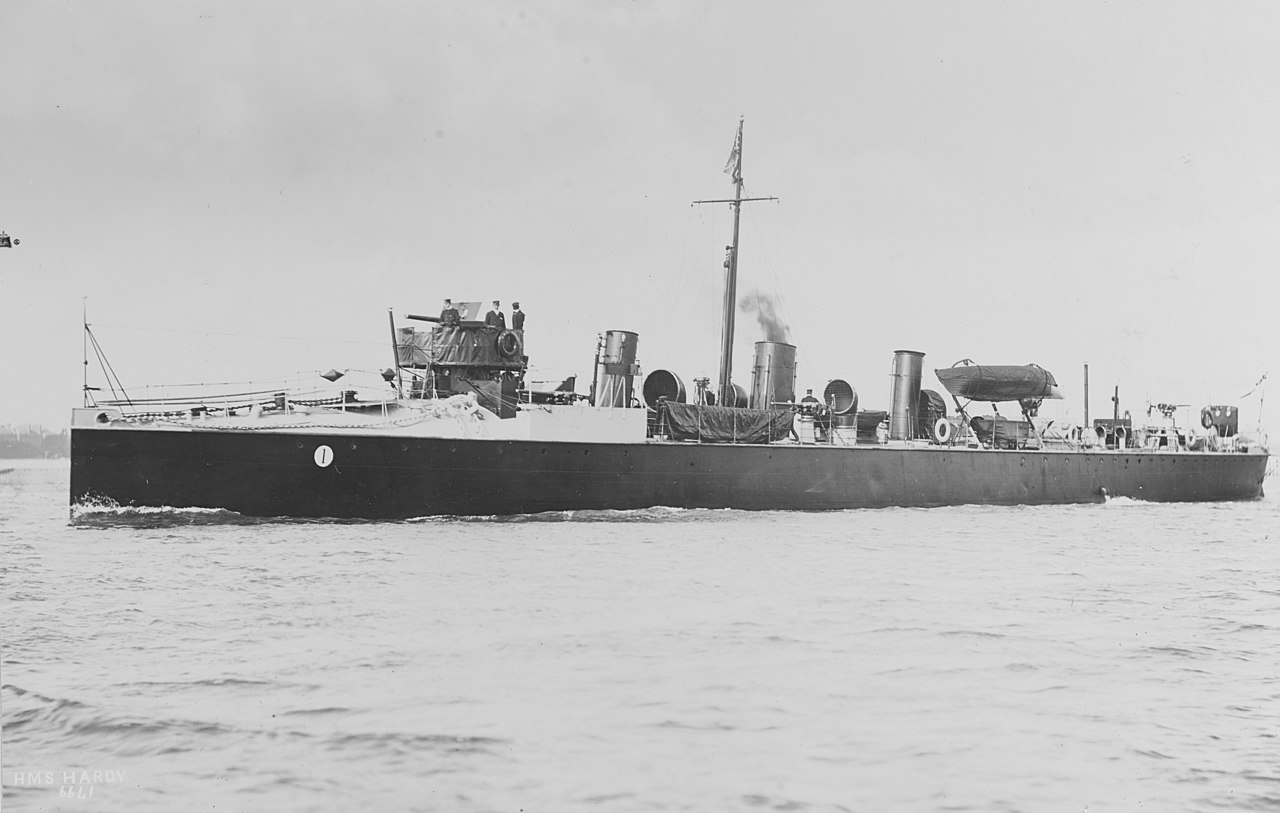
 Latest Facebook Entry -
Latest Facebook Entry -  X(Tweeter) Naval Encyclopedia's deck archive
X(Tweeter) Naval Encyclopedia's deck archive Instagram (@navalencyc)
Instagram (@navalencyc)





 French Navy
French Navy Royal Navy
Royal Navy Russian Navy
Russian Navy Armada Espanola
Armada Espanola Austrian Navy
Austrian Navy K.u.K. Kriegsmarine
K.u.K. Kriegsmarine Dansk Marine
Dansk Marine Nautiko Hellenon
Nautiko Hellenon Koninklije Marine 1870
Koninklije Marine 1870 Marinha do Brasil
Marinha do Brasil Osmanlı Donanması
Osmanlı Donanması Marina Do Peru
Marina Do Peru Marinha do Portugal
Marinha do Portugal Regia Marina 1870
Regia Marina 1870 Nihhon Kaigun 1870
Nihhon Kaigun 1870 Preußische Marine 1870
Preußische Marine 1870 Russkiy Flot 1870
Russkiy Flot 1870 Svenska marinen
Svenska marinen Søværnet
Søværnet Union Navy
Union Navy Confederate Navy
Confederate Navy Armada de Argentina
Armada de Argentina Imperial Chinese Navy
Imperial Chinese Navy Marinha do Portugal
Marinha do Portugal Mexico
Mexico Kaiserliche Marine
Kaiserliche Marine 1898 US Navy
1898 US Navy Sovietskiy Flot
Sovietskiy Flot Royal Canadian Navy
Royal Canadian Navy Royal Australian Navy
Royal Australian Navy RNZN Fleet
RNZN Fleet Chinese Navy 1937
Chinese Navy 1937 Kriegsmarine
Kriegsmarine Chilean Navy
Chilean Navy Danish Navy
Danish Navy Finnish Navy
Finnish Navy Hellenic Navy
Hellenic Navy Polish Navy
Polish Navy Romanian Navy
Romanian Navy Turkish Navy
Turkish Navy Royal Yugoslav Navy
Royal Yugoslav Navy Royal Thai Navy
Royal Thai Navy Minor Navies
Minor Navies Albania
Albania Austria
Austria Belgium
Belgium Columbia
Columbia Costa Rica
Costa Rica Cuba
Cuba Czechoslovakia
Czechoslovakia Dominican Republic
Dominican Republic Haiti
Haiti Hungary
Hungary Honduras
Honduras Estonia
Estonia Iceland
Iceland Eire
Eire Equador
Equador Iran
Iran Iraq
Iraq Latvia
Latvia Liberia
Liberia Lithuania
Lithuania Mandchukuo
Mandchukuo Morocco
Morocco Nicaragua
Nicaragua Persia
Persia San Salvador
San Salvador Sarawak
Sarawak Uruguay
Uruguay Venezuela
Venezuela Zanzibar
Zanzibar Warsaw Pact Navies
Warsaw Pact Navies Bulgaria
Bulgaria Hungary
Hungary

 Bundesmarine
Bundesmarine Dutch Navy
Dutch Navy Hellenic Navy
Hellenic Navy Marina Militare
Marina Militare Yugoslav Navy
Yugoslav Navy Chinese Navy
Chinese Navy Indian Navy
Indian Navy Indonesian Navy
Indonesian Navy JMSDF
JMSDF North Korean Navy
North Korean Navy Pakistani Navy
Pakistani Navy Philippines Navy
Philippines Navy ROKN
ROKN Rep. of Singapore Navy
Rep. of Singapore Navy Taiwanese Navy
Taiwanese Navy IDF Navy
IDF Navy Saudi Navy
Saudi Navy Royal New Zealand Navy
Royal New Zealand Navy Egyptian Navy
Egyptian Navy South African Navy
South African Navy






























 Ukrainian Navy
Ukrainian Navy dbodesign
dbodesign